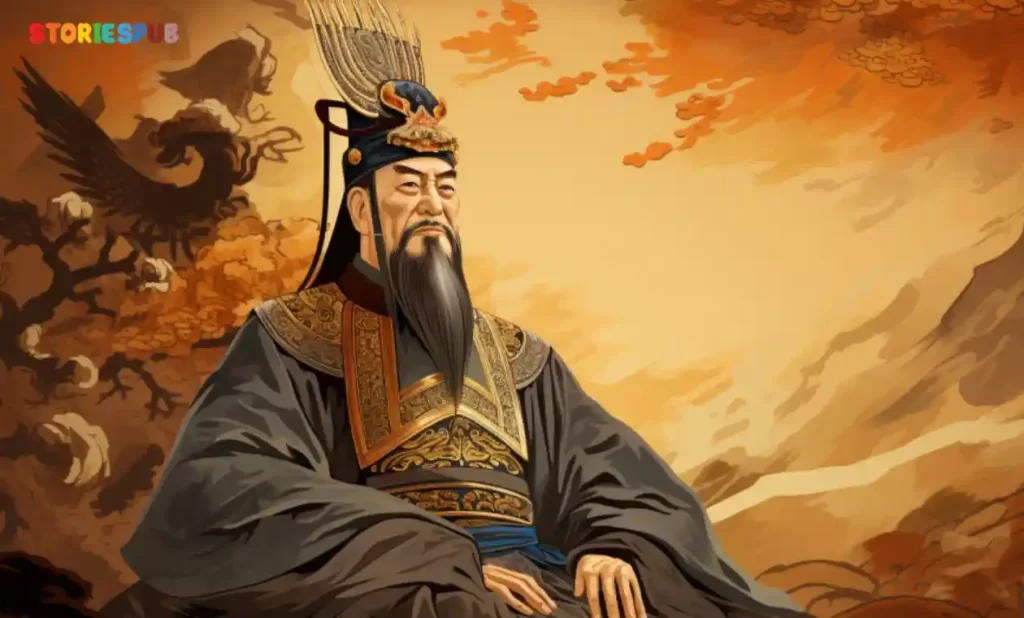
In ancient China, there was a powerful emperor named Qin Shi Huang, who ruled during the Qin Dynasty. Qin Shi Huang was born in 259 BCE, and his reign is known for his military conquests, unification of China, and significant cultural and artistic achievements.
The story of the Qin Emperor’s early life begins with his birth in the year 259 BCE. He was born as Ying Zheng, the second son of King Zhuangxiang of Qin, one of the seven major states that made up China during that time.
At the age of 13, after his father’s sudden death, Ying Zheng ascended to the throne as the King of Qin. However, due to his young age and lack of experience, his mother, Lady Zhao, acted as the regent until he came of age.
During this period of regency, Lady Zhao and her advisors consolidated their power and secured the loyalty of the Qin court. They also implemented policies aimed at strengthening the state’s military and political power, which would later become the foundation for Ying Zheng’s vision of unifying China.
As he grew up, Ying Zheng became interested in politics and warfare. He received an education in the arts of war, literature, and philosophy. However, his interest in warfare and politics exceeded that of his education. He was a fierce and ambitious ruler who had a vision of unifying all the warring states of China under his rule.
Ying Zheng was heavily influenced by the philosophy of Legalism, which emphasized strict laws and harsh punishments to maintain social order and control. Legalism had gained popularity in the state of Qin during the reign of his grandfather and father, and it continued to shape the policies and ideology of the Qin court during his reign.
Under Ying Zheng’s rule, the Qin state began a series of military campaigns aimed at conquering and annexing the other six states of China. These campaigns were carried out with ruthless efficiency, and they brought the Qin state considerable wealth and power.
The Qin Emperor’s belief in Legalism was evident in his approach to governance. He implemented a series of strict laws and regulations aimed at maintaining social order and control. For example, he standardized weights and measures, abolished feudalism, and enforced a strict legal code that prescribed harsh punishments for even minor offenses.
Ying Zheng’s unification of China was a long and arduous process. It took several years of military campaigns, diplomacy, and strategic alliances to achieve his goal.
Under his rule, the Qin Dynasty became the dominant power in China through military conquests. He conquered the six other states of China and brought them under the Qin Empire. He was known for his military strategies and tactics, which included the use of cavalry, chariots, and infantry.
The Battle of Changping was one of the most significant battles that took place during the Qin Dynasty. It occurred in 260 BCE and was fought between the Qin army and the Zhao state. The Qin army was led by General Bai Qi, while the Zhao army was led by General Lian Po.
The battle was the result of longstanding tensions between the Qin and Zhao states. The Qin state had been expanding its territories through military campaigns and had become a significant threat to the other states. The Zhao state, which was located to the northeast of the Qin state, was particularly vulnerable to Qin expansion.
General Lian Po, who was known for his military prowess, had been tasked with defending the Zhao state against Qin aggression. He had built a series of fortifications along the border to prevent Qin incursions into Zhao territory.
However, the Qin Emperor was determined to conquer the Zhao state and ordered General Bai Qi to lead an army of 600,000 soldiers to attack the Zhao fortifications. General Bai Qi was known for his ruthlessness and military strategy, and he was confident that he could defeat the Zhao army.
The Battle of Changping lasted for several months and was marked by brutal and bloody fighting. The Qin army employed various tactics, such as digging tunnels and trenches, to breach the Zhao fortifications. The Zhao army, led by General Lian Po, put up a fierce resistance and inflicted heavy casualties on the Qin army.
However, General Bai Qi was relentless and determined. He ordered his soldiers to dig a tunnel under the Zhao fortifications and set fire to it, causing the walls to collapse. This allowed the Qin army to breach the Zhao defenses and launch a devastating attack on the Zhao army.
The Battle of Changping was a decisive victory for the Qin army, and it led to the complete annexation of the Zhao state. The Qin Emperor was pleased with General Bai Qi’s victory and rewarded him with great honors and wealth.
The Battle of Changping had a significant impact on the Qin Dynasty and Chinese history. It demonstrated the power and military might of the Qin state and solidified its position as the dominant power in China. It also marked the beginning of the end for the other states, which would eventually be conquered and annexed by the Qin state.
The Qin Emperor was also known for his political policies, which were aimed at centralizing power and control. He standardized weights and measures, standardized the Chinese script, and built an extensive network of roads and canals to facilitate communication and trade.
The Qin Emperor’s most notable achievement was the construction of the Great Wall of China. The wall was built to protect the empire from the invasions of the nomadic tribes in the north. It is estimated that over 1 million laborers worked on the construction of the wall, and it stretches over 13,000 miles across northern China.
The Qin Dynasty was also known for its cultural and artistic achievements. The Qin Emperor patronized the arts and was responsible for the creation of the famous Terra Cotta Army, which was a collection of thousands of life-sized clay soldiers that were buried with him.
The Qin Dynasty was a time of great political and cultural change in China, and several notable figures played a significant role during this period. Two of the most prominent figures were Li Si and Sima Qian.
Li Si was a high-ranking official and prime minister during the Qin Dynasty. He was one of the chief architects of the Legalist policies that were implemented by the Qin Emperor. Li Si believed in the importance of strict laws and harsh punishments to maintain social order and control, and he played a key role in shaping the legal system and policies of the Qin state.
Li Si was known for his intelligence and administrative skills. He was responsible for the standardization of weights and measures, the creation of a standardized Chinese script, and the establishment of a complex bureaucracy to administer the empire. He also played a significant role in the military campaigns that led to the unification of China under the Qin Dynasty.
Despite his many achievements, Li Si’s influence was not always positive. He was known for his ruthlessness and was responsible for the burning of books and the burying of scholars. These actions were carried out to suppress dissent and maintain social control, but they were also a significant blow to Chinese culture and scholarship.
Sima Qian was another notable figure during the Qin Dynasty. He was a historian and writer who is best known for his comprehensive historical text, Records of the Grand Historian. The text covers the period from the legendary Xia Dynasty to the Han Dynasty and is considered one of the most important historical texts in Chinese literature.
Sima Qian was born into a family of scholars and was trained in the art of history and literature. He worked as a court historian during the reign of the Han Emperor Wu and was known for his meticulous research and attention to detail. He interviewed eyewitnesses and consulted official records to ensure the accuracy of his work.
Sima Qian’s historical text, Records of the Grand Historian, was a groundbreaking work that set the standard for Chinese historiography. It covered a vast period of history and provided a comprehensive and detailed account of Chinese civilization up to that point. The text also included biographical accounts of notable figures, such as Confucius and the Qin Emperor.
Despite the significance of his work, Sima Qian faced personal and professional challenges during his lifetime. He was convicted of a crime and sentenced to castration, which was a significant blow to his reputation and social standing. However, he continued to work on his historical text and completed it shortly before his death.
The military played a crucial role in the Qin Emperor’s rule. The army was well-organized and disciplined, and it was responsible for the conquest and annexation of the other states. The army was also responsible for the construction of the Great Wall of China.
The Qin Emperor’s rule had a significant impact on the common people of China. He standardized weights and measures, which made trade and commerce more accessible. However, his harsh policies also led to widespread resentment and rebellion, which ultimately led to the downfall of the Qin Dynasty.
Despite his many achievements, the Qin Emperor’s legacy is controversial. He was known for his harsh and brutal policies, which included the burning of books and the burying of scholars. He also had a massive tomb complex built for himself, which included the famous Terra Cotta Army.
In conclusion, the Qin Emperor’s epic tale is one of the most significant stories in Chinese history. His reign was characterized by military conquests, political policies, and cultural achievements. The legacy of the Qin Dynasty continues to influence Chinese culture and society to this day.
Hey kids, how much did you like Unifying China: The Rise of the Qin Emperor? Please share your view in the comment box. Also, please share this story with your friends on social media so they can also enjoy it, and for more such Chinese Mythology, please bookmark storiespub.com.
Related Post :
FAQ about Qin Emperor
When did the Qin Dynasty rule China?
The Qin Dynasty ruled China from 221 BCE to 206 BCE.
Who was the first emperor of the Qin Dynasty?
The first emperor of the Qin Dynasty was Qin Shi Huang, who was also known as Ying Zheng.
How did the Qin Emperor unify China?
The Qin Emperor unified China through military conquests, diplomacy, and strategic alliances.
What was the philosophy of Legalism?
Legalism was a philosophy that emphasized strict laws and harsh punishments to maintain social order and control.
What was the significance of the Great Wall of China during the Qin Dynasty?
The Great Wall of China was built during the Qin Dynasty to protect the empire from the invasions of the nomadic tribes in the north.
What was the Terra Cotta Army?
The Terra Cotta Army was a collection of thousands of life-sized clay soldiers that were buried with the Qin Emperor to protect him in the afterlife.
Who were some of the notable figures that played a role during the Qin Dynasty?
Some of the notable figures during the Qin Dynasty included Li Si, who was the prime minister and one of the chief architects of Legalist policies, and Sima Qian, who was a historian and writer known for his comprehensive historical text, Records of the Grand Historian.
What were some of the cultural and artistic achievements of the Qin Dynasty?
The Qin Dynasty was known for its cultural and artistic achievements, including the creation of the Terra Cotta Army, the standardization of the Chinese script, and the construction of the Great Wall of China.
How did the Qin Emperor's rule impact the common people of China?
The Qin Emperor's rule had both positive and negative impacts on the common people of China. On one hand, his policies and reforms, such as the standardization of weights and measures, made trade and commerce more accessible. On the other hand, his harsh policies and brutal punishments led to widespread resentment and rebellion.
What was the legacy of the Qin Dynasty in Chinese history and culture?
The Qin Dynasty's legacy in Chinese history and culture is significant. It marked the beginning of the imperial era in China and laid the foundation for future dynasties. The legacy of the Qin Dynasty also includes the Great Wall of China, the Terra Cotta Army, and the enduring influence of Legalist philosophy on Chinese governance and society.


















